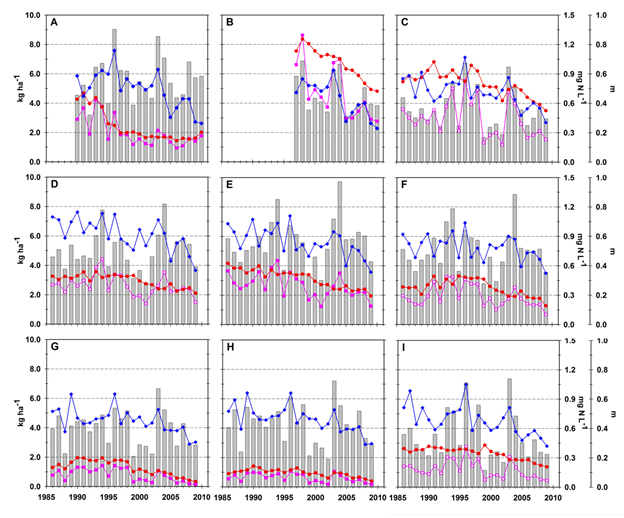Background
Over the past century, the production of reactive nitrogen (N) on earth has accelerated dramatically. This resulting accumulation of N has significant consequences for air quality, human health, terrestrial productivity, and both acidification and eutrophication of aquatic ecosystems. Reductions in emissions from stationary sources like power plants as a result of the Clean Air Act Amendments Acid Rain Program (ARP) and other "cap and trade" programs in addition to reductions in NOx emissions from mobile sources have resulted in an estimated 32% decline in total anthropogenic NOx emissions between 1997 and 2005 in 20 states in the eastern U.S.
Unlike with SO2 emission controls, few studies have demonstrated long-term decreasing trends in surface water nitrate-N concentrations as a result of these reductions in deposition of nitrate. Data from some of the longest running forest ecosystem studies have failed to produce any significant relationships between N deposition and streamwater loads. Changes in N dynamics in forests have particular relevance for efforts to restore freshwater and estuarine ecosystems, such as the Chesapeake Bay. While forest nitrate-N loads are not thought to dominate the overall N load to the Bay, the fact that about 60% of the watershed is forested increases the need for water quality managers to more accurately account for forest N dynamics. In this project, we evaluated long-term atmospheric deposition and water quality trends for a group of nine forested Appalachian Mountain watersheds during a multi-decadal period in which regional NOx emissions have been progressively reduced. We also report on the sensitivity of nitrate-N yields to reductions in atmospheric N deposition through application of a simple, kinetic N saturation model and discuss the implications for managing water quality across the entire Chesapeake Bay watershed.
We identified nine forested watersheds that are either minimally affected or not affected by N pollution from agriculture or development with extensive daily discharge and periodic water quality data that are suitable for analysis of long-term nitrate-N load and concentration trends. The watersheds are all located along the spine of the Appalachian Mountains from Pennsylvania to southern Virgina (see map at left). Water quality and discharge data were available for the 24 year period from 1 October 1985 through 30 September 2009 with the exception of two smaller watersheds with shorter data records. We computed continuous daily nitrate-N loads for each station using a standard estimation method (LOADEST) that models the nitrate-N load using a seven-parameter multiple linear regression model using maximum likelihood estimation.
In addition to surface water N concentrations, we examined annual wet inorganic N deposition for calendar years 1986-2009 for stations that are part of the National Acid Deposition Program (NADP) network that surround the Chesapeake Bay basin and our study watersheds. We then applied a kinetic N saturation model to the watersheds.
Our results (see figure below) provide strong empirical evidence of decreasing trends in both annual areal wet N deposition and nitrate-N yields for all nine forested watersheds during the study periods. Additionally, statistically significant decreasing linear trends in discharge-weighted nitrate-N concentrations were observed for all nine watersheds during this same period.
The figure below illustrates temporal patterns (1986-2009) in annual (1) nitrate-N yields (kg ha-1, pink lines/squares), (2) areal N deposition (kg ha-1, blue lines/diamonds), (3) nitrate-N concentrations (mg N L-1, red lines/circles), and (4) runoff (m, gray bars) for the nine study watersheds. Time series illustrated with solid symbols produced statistically significant linear trends. The stations are A: Upper Big Run (MD); B: Black Lick (MD); C: Potomac River at Hancock (MD); D: Driftwood Branch Sinnemahoning Creek (PA); E: Kettle Creek (PA); F: Pine Creek (PA); G: Jackson River (VA); H: Cowpasture River (VA); and I: Cedar Creek (VA):

Not only were these trends significant, but they were robust across a large geographical region and appeared insensitive to watershed size across several orders of magnitude. This suggests that the improvements in water quality are probably propagated to surface and estuarine waters downstream.
Our results suggest that surface waters are responding to declining atmospheric deposition of nitrogen in much the same way that they responded to declining sulfur deposition. Further reductions in N deposition throughout the region would be expected to produce additional proportionate reductions in streamwater N loads.

